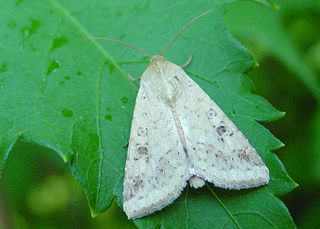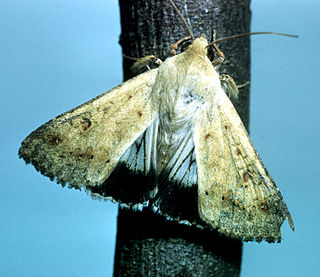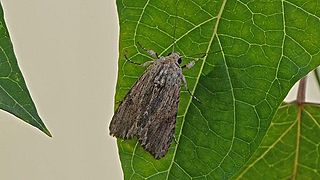
Gossypium is a genus of flowering plants in the tribe Gossypieae of the mallow family, Malvaceae, from which cotton is harvested. It is native to tropical and subtropical regions of the Old and New Worlds. There are about 50 Gossypium species, making it the largest genus in the tribe Gossypieae, and new species continue to be discovered. The name of the genus is derived from the Arabic word goz, which refers to a soft substance.

Helicoverpa zea, commonly known as the corn earworm, is a species in the family Noctuidae. The larva of the moth Helicoverpa zea is a major agricultural pest. Since it is polyphagous during the larval stage, the species has been given many different common names, including the cotton bollworm and the tomato fruitworm. It also consumes a wide variety of other crops.

Bollworm is the common term for a moth larva that attacks the fruiting bodies of certain crops, especially cotton. The most common moths known as bollworms are:

The pink bollworm is an insect known for being a pest in cotton farming. The adult is a small, thin, gray moth with fringed wings. The larva is a dull white caterpillar with eight pairs of legs with conspicuous pink banding along its dorsum. The larva reaches one half inch in length.
Bt cotton is a genetically modified organism (GMO) or genetically modified pest resistant plant cotton variety, which produces an insecticide to combat bollworm.

The cotton bollworm, corn earworm, or Old World (African) bollworm is a moth, the larvae of which feed on a wide range of plants, including many important cultivated crops. It is a major pest in cotton and one of the most polyphagous and cosmopolitan pest species. It should not be confused with the similarly named, related species Helicoverpa zea.

Spodoptera littoralis, also referred to as the African cotton leafworm or Egyptian cotton leafworm or Mediterranean brocade, is a species of moth in the family Noctuidae. S. littoralis is found widely in Africa, Mediterranean Europe and Middle Eastern countries. It is a highly polyphagous organism that is a pest of many cultivated plants and crops. As a result, this species was assigned the label of A2 quarantine pest by the EPPO and was cautioned as a highly invasive species in the United States. The devastating impacts caused by these pests have led to the development of both biological and chemical control methods. This moth is often confused with Spodoptera litura.
Central Cotton Research Institute Multan, established in 1970 in Multan, Pakistan, is one of the renowned research institutes of Pakistan. The institute has many divisions dedicated to different aspects of cotton research including Agronomy, Breeding and Genetics, Cytogenetics, Physiology, Fiber Technology, Statistics and Agricultural Engineering. Over the years, many achievements have been made in the development of high yielding varieties with standard fibre quality characteristics like staple length, fineness and strength etc. The fine tuning of production technology at the grass-root level of common farming community to the progressive farmers has made tremendous impact on enhancing cotton productivity.

Earias is a genus of moths in the monotypic subfamily Eariadinae of the family Nolidae. The genus was erected by Jacob Hübner in 1825. Species are found throughout Europe, Africa, Asia and Australia, some being agricultural pests such as bollworms.

Helicoverpa punctigera, the native budworm, Australian bollwormor Chloridea marmada, is a species of moth in the family Noctuidae. This species is native to Australia. H. punctigera are capable of long distance migration from their inland Australian habitat towards coastal regions and are an occasional migrant to New Zealand.

Heliothis punctifera or the lesser budworm, is an Australian moth of the family Noctuidae; one of the most migratory families of insects. It is considered a pest species to agricultural crops, however, due to its inland habitat, is found to be less damaging to agricultural areas than other species of the genus.

Chloridea virescens, commonly known as the tobacco budworm, is a moth of the family Noctuidae found throughout the eastern and southwestern United States along with parts of Central America and South America.

Spodoptera eridania is a moth that is known to be a pest. They are one of the most important defoliators in the tropical and subtropical regions of the western hemisphere that feed heavily on plants while they are young, often resulting in skeleton leaves on their food plants. They are also heavy feeders on tomato in Florida. There is a lot of development in producing pesticides against the S. eridania, specifically a neem-based pesticide that can result in smaller and prolonged development. The wingspan is 33–38 mm. Adults are on wing year-round. The larvae feed on various weeds but prefer Amaranthus species and Phytolacca americana.

A pheromone trap is a type of insect trap that uses pheromones to lure insects. Sex pheromones and aggregating pheromones are the most common types used. A pheromone-impregnated lure, as the red rubber septa in the picture, is encased in a conventional trap such as a bottle trap, Delta trap, water-pan trap, or funnel trap. Pheromone traps are used both to count insect populations by sampling, and to trap pests such as clothes moths to destroy them.

Alabama argillacea, the cotton leafworm or cotton worm, is a moth of the family Erebidae. It is native to the New World, but has been extirpated from the United States and Canada, having not been recorded since 1998. In the Neotropics, it can be found from Mexico to northern Argentina. The larva is considered a pest of cotton. They feed on the leaves, twigs, and buds.

Earias insulana, the Egyptian stemborer, Egyptian bollworm, spiny bollworm or cotton spotted bollworm, is a moth of the family Nolidae. The species was first described by Jean Baptiste Boisduval in 1833. It is found in most of Africa, southern Europe, the Near East and Middle East, Japan, Taiwan, the Philippines, Australia and Hawaii. It is a rare in immigrant in Great Britain.

Earias biplaga, the spiny bollworm, is a moth in the family Nolidae. The species was first described by Francis Walker in 1866. It is found throughout subtropical Africa including Atlantic and Indian Ocean islands.
Rabila frontalis, the red bollworm, is a moth of the family Noctuidae. The species was first described by Francis Walker in 1865. It is found in India and Sri Lanka.

Diparopsis castanea is the type species of the genus Diparopsis: moths in the family Noctuidae; no subspecies are listed in the Catalogue of Life. This is known as the red bollworm, which is a significant pest of cotton crops in Eastern and Central-Southern Africa.

Earias cupreoviridis, called the cupreous bollworm as a larva, is a moth of the family Nolidae. The species was first described by Francis Walker in 1862. It is found in African countries like Botswana, the Democratic Republic of the Congo, Eritrea, Ethiopia, the Gambia, Kenya, Nigeria, Sierra Leone, South Africa, Togo, Uganda, Zimbabwe to Asian countries like India, Sri Lanka, China, Japan, Korea, Philippines, Indonesia and Hong Kong.














